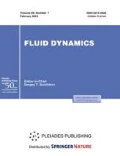Abstract
The analytical results of the nonlinear theory of wave packets are tested against experiments performed in a water tank and compared with the analytical results of the linear theory of low-amplitude waves and the theory of weakly nonlinear gravitational waves on the free fluid surface infinite in extent. The results of experiments and observations well-known in the literature are used for testing.







Similar content being viewed by others
REFERENCES
Landau, L.D. and Lifshitz, E.M., Fluid Mechanics, 2nd ed., New York: Pergamon, 1987; Moscow: Nauka, 1986.
Yuen, H.C. and Lake, B.M., Nonlinear Dynamics of Deep-Water Gravity Waves,Advances in Applied Mechanics, vol. 22, New York, London: Academic, 1982, p. 67.
Mindlin, I.M., Integrodifferentsial’nye uravneniya v dinamike tyazheloi sloistoi zhidkosti (Integrodifferential Equations in a Heavy Layered Liquid), Moscow: Nauka, 1996.
Mindlin, I.M., Nonlinear waves in a heavy two-layer liquid generated by an extended initial disturbance of the horizontal interface: Exact solution. Fluid Dynamics, 1995, vol. 30, no. 6, pp. 943–946.
Mindlin, I.M., Nonlinear waves in two-dimensions generated by variable pressure acting on the free surface of a heavy liquid, J. Appl. Math. Phys.(ZAMP), 2004, vol. 55, pp. 781–799.
Mindlin, I.M., Deep-water gravity waves: nonlinear theory of wave groups, June 6, 2014. http://arxiv.org/abs/1406.1681
Feir, J.E., Discussion: Some results from wave pulse experiments, in: A Discussion on Nonlinear Theory of Wave Propagation in Dispersive Systems. Proc. R. Soc. Lond., 1967, vol. 299, pp. 54–58.
Mindlin, I.M., Two Kuril tsunamis and analytical long wave theory, August 31, 2018. http://arxiv.org/abs/1809.00987
Author information
Authors and Affiliations
Corresponding author
Additional information
Translated by E.A. Pushkar
CLASSICAL EQUATIONS IN THE CURVILINEAR COORDINATES \(\sigma ,\theta \)
CLASSICAL EQUATIONS IN THE CURVILINEAR COORDINATES \(\sigma ,\theta \)
Points \(P\) and Q are mentioned in the integral for the velocity potential; point \(P\) has the curvilinear coordinates \(\sigma ,\theta \) and point Q has the coordinates \({{\sigma }_{1}},\;{{\theta }_{1}}\) at \({{\sigma }_{1}} = 0\).
In the curvilinear coordinates the velocity potential can be written as follow:
where
Nonlinear equations (A2) and (A3) are, respectively, the kinematic condition on the free fluid surface and the pressure continuity condition on this surface
The conditions at infinity can be taken in the form:
Conditions (A4) guarantee that the perturbation source in fluid imparts finite energy to the fluid.
Rights and permissions
About this article
Cite this article
Mindlin, I.M. Water Waves: Theory and Experiments. Fluid Dyn 55, 498–510 (2020). https://doi.org/10.1134/S001546282003009X
Received:
Revised:
Accepted:
Published:
Issue Date:
DOI: https://doi.org/10.1134/S001546282003009X



